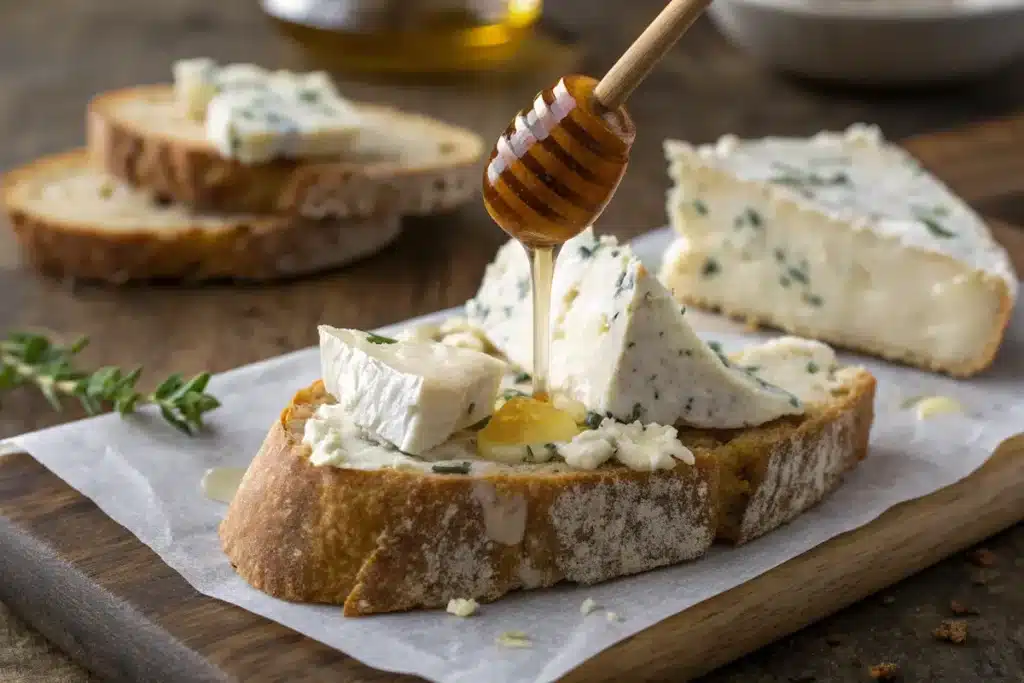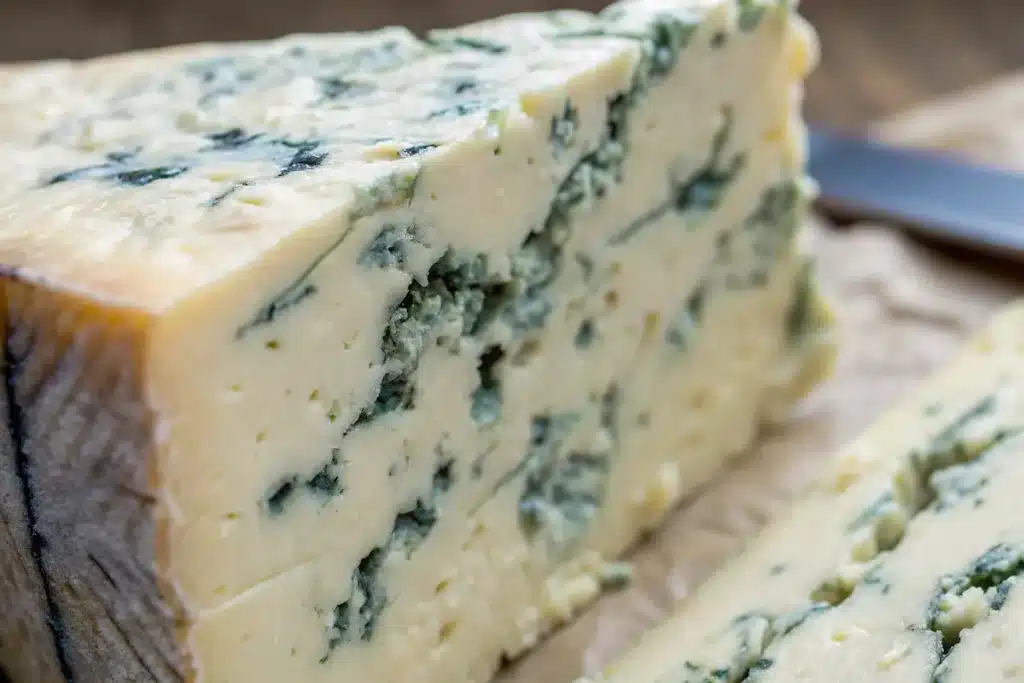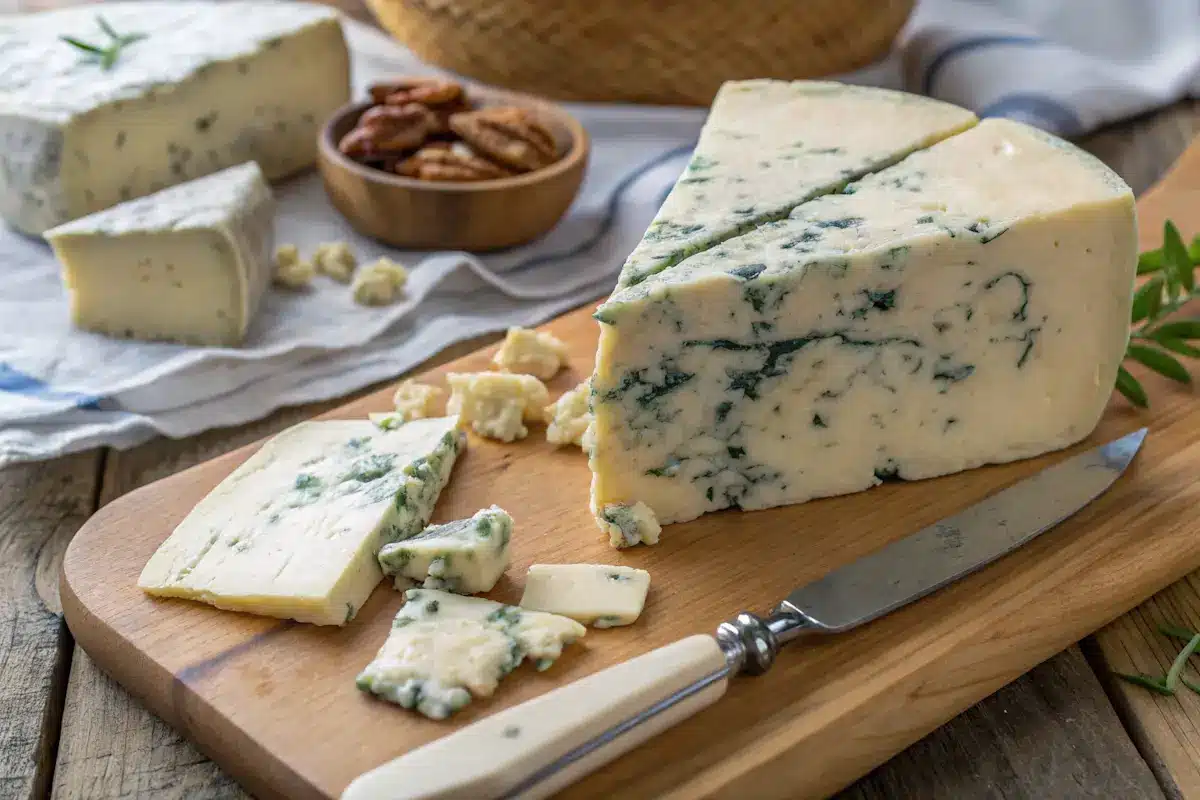Are blue cheese and Gorgonzola the same? Many people assume that Gorgonzola is just another type of blue cheese, but while they share similarities, they are not identical.
Blue cheese refers to a broad category of cheeses that develop blue veins through a specific ageing process, while Gorgonzola is a specific type of Italian blue cheese with its own unique characteristics.
In this article, we’ll explore:
✔️ The key differences between Gorgonzola and other blue cheeses
✔️ How Gorgonzola is made and what makes it unique
✔️ The role of blue mould in these cheeses
✔️ What cheeses are closest to blue cheese in flavour
By the end, you’ll know exactly how Gorgonzola compares to other blue cheeses and which one is best for your recipes!
Table of Contents
1: What Is the Difference Between Gorgonzola and Blue Cheese?
While Gorgonzola is a type of blue cheese, not all blue cheese is Gorgonzola. The main differences lie in their origin, flavour, texture, and ageing process. Let’s break it down.
1. Origin and History: Gorgonzola vs. Other Blue Cheeses
- Gorgonzola is a PDO (Protected Designation of Origin) cheese that comes exclusively from Italy, mainly from Lombardy and Piedmont. It is one of the oldest blue cheeses, dating back over 1,000 years.
- Other blue cheeses, such as Roquefort (France), Stilton (England), and Danish Blue (Denmark), have their own distinct histories, regions, and production methods.
Fun Fact: Gorgonzola is considered one of the mildest blue cheeses, making it a great option for those new to blue cheese flavours.
2. Differences in Milk Source, Texture, and Flavor
| Cheese | Milk Type | Texture | Flavor Profile |
|---|---|---|---|
| Gorgonzola | Cow’s milk | Soft to crumbly | Mild, tangy, slightly sweet |
| Roquefort | Sheep’s milk | Moist, crumbly | Sharp, pungent, salty |
| Stilton | Cow’s milk | Firm, creamy | Nutty, rich, strong |
| Danish Blue | Cow’s milk | Crumbly | Salty, sharp, bold |
- Gorgonzola is creamy and smooth (especially Gorgonzola Dolce), while Roquefort and Danish Blue are sharper, saltier, and more pungent.
- Stilton is firmer, making it ideal for cheese boards, whereas Gorgonzola melts well into sauces and pasta dishes.
Best Choice: If you prefer mild, creamy blue cheese, Gorgonzola is the way to go. If you like bold, sharp flavours, Roquefort or Danish Blue might be better.
3. How Aging Affects Their Taste
- Gorgonzola Dolce (Aged 2-3 months) → Soft, spreadable, mild, slightly sweet
- Gorgonzola Piccante (Aged 3-6 months) → Crumbly, sharper, tangier
- Roquefort & Stilton (Aged longer than Gorgonzola) → More intense, saltier, stronger aroma
Takeaway: Gorgonzola ages faster than other blue cheeses, which keeps it milder and less salty than Roquefort or Stilton.
Now that we’ve explored what makes Gorgonzola different, let’s take a closer look at how it’s made and why it has such a unique texture and flavour.
Looking for a recipe using Gorgonzola? 10 Amazing Facts About Gorgonzola Cheese: Taste, Benefits & Uses

2: Are Blue Cheese and Gorgonzola the Same in Terms of Cheese Type?
Gorgonzola is a PDO-certified blue cheese made from cow’s milk and aged for several months to develop its distinct creamy texture and tangy flavour. Unlike stronger blue cheeses like Roquefort (made from sheep’s milk), Gorgonzola has a milder, more approachable taste that makes it a favourite among cheese lovers.
1. How Gorgonzola Is Made (PDO Certification & Aging Process)
To be labelled authentic Gorgonzola, the cheese must be produced in specific regions of Italy, following strict PDO (Protected Designation of Origin) regulations. Here’s how it’s made:
1️⃣ Fresh cow’s milk is heated and mixed with Penicillium mould cultures.
2️⃣ Rennet and enzymes are added to help the milk curdle.
3️⃣ The curds are drained, shaped into wheels, and salted to enhance flavour.
4️⃣ The cheese is aged in temperature-controlled caves for 2 to 6 months.
5️⃣ During ageing, the wheels are pierced with needles, allowing oxygen to enter and helping the blue veins develop.
Fun Fact: The needling process is what gives Gorgonzola its signature blue-green mould, which creates its rich, tangy taste!
2. Two Types of Gorgonzola: Dolce vs. Piccante
Gorgonzola comes in two main varieties, each with a different texture and flavor profile:
| Type | Aging Time | Texture | Flavor Profile | Best Uses |
|---|---|---|---|---|
| Gorgonzola Dolce | 2-3 months | Soft, creamy | Mild, slightly sweet | Spreads, sauces, pizza |
| Gorgonzola Piccante | 3-6 months | Firmer, crumbly | Stronger, tangy, spicy | Salads, pasta, cheese boards |
- Gorgonzola Dolce is perfect for spreading on bread or melting into creamy sauces.
- Gorgonzola Piccante has a stronger bite and works best for salads, burgers, or crumbling over dishes.
Which one should you choose? If you’re new to blue cheese, start with Gorgonzola Dolce. If you prefer a bold, sharp flavour, go for Gorgonzola Piccante.
Now that we understand what kind of cheese Gorgonzola is, let’s answer a common question: Is the Blue in Gorgonzola actually mould?

3: Is the Blue in Gorgonzola Mold?
Yes! The blue veins in Gorgonzola are a type of edible mould called Penicillium. Unlike harmful moulds that grow on spoiled food, the mould in Gorgonzola is completely safe to eat and plays an important role in its flavour, texture, and health benefits.
1. What Causes the Blue Veins in Gorgonzola?
During the cheese-making process, Penicillium roqueforti or Penicillium glaucum mould spores are added to the milk. As the cheese ages, the following process occurs:
1️⃣ The cheese wheels are pierced with needles, allowing oxygen to enter.
2️⃣ The oxygen activates the Penicillium mould, causing it to grow and create blue-green veins throughout the cheese.
3️⃣ Over time, the mould develops Gorgonzola’s tangy, slightly spicy taste.
Fun Fact: The same Penicillium mould found in Gorgonzola is used to produce the antibiotic penicillin, though the mould in cheese doesn’t have antibiotic properties.
2. Is the Mold in Gorgonzola Safe to Eat?
✅ Yes! The mould in Gorgonzola is not harmful and is actually a major reason for its unique flavour and creamy texture.
✔ It prevents harmful bacteria growth, keeping the cheese safe.
✔ It enhances digestion by breaking down fats and proteins.
✔ It creates the cheese’s signature sharp, earthy taste.
* When to Avoid Gorgonzola’s Mold:
- If you have a mould allergy, you may react to Penicillium mould.
- Pregnant women should only eat pasteurized Gorgonzola, as soft cheeses carry a risk of Listeria bacteria.
- If the cheese develops pink, orange, or black spots, it may be spoiled.
Tip: If you’re sensitive to blue cheese flavours, try Gorgonzola Dolce, which has less mould growth and a milder taste than the aged Piccante variety.
Now that we know the blue mould in Gorgonzola is safe and essential for flavour let’s explore what cheeses are closest to blue cheese and how to find substitutes.
4: Gorgonzola vs Is Closest to Blue Cheese?
If you love blue cheese but want to explore other options, several kinds of cheese offer similar flavours and textures. Whether you’re looking for a mild alternative to Gorgonzola or a stronger, sharper blue cheese, here’s a breakdown of the best substitutes.
1. Best Substitutes for Blue Cheese (Mild to Strongest)
| Cheese | Flavor Strength | Texture | Best For |
|---|---|---|---|
| Gorgonzola Dolce | Mild | Soft, creamy | Spreads, sauces, pasta |
| Danish Blue | Medium | Crumbly, moist | Burgers, salads, dressings |
| Stilton | Medium-Strong | Firm, creamy | Cheese boards, soups |
| Roquefort | Strong | Moist, crumbly | Bold-flavored dishes, steak toppings |
- If you want a mild blue cheese, go for Gorgonzola Dolce or Danish Blue.
- For a bolder taste, Stilton and Roquefort deliver sharper, saltier flavors.
Best all-around substitute? Danish Blue is closest to Gorgonzola Piccante, offering similar creaminess with a balanced tang.
2. Can You Replace Gorgonzola with Another Cheese?
Yes! Depending on the recipe, here are good swaps for Gorgonzola:
✔ For pasta & sauces: Danish Blue or Stilton (creamy texture, melts well)
✔ For salads & dressings: Roquefort (bold and crumbly)
✔ For pizza & burgers: Blue Stilton (sharp but balanced flavour)
✔ For mild cheese lovers: Goat cheese or feta (similar texture, less tang)
Tip: If you don’t like strong blue cheese flavours, mix Gorgonzola with cream cheese or mascarpone to tone down the sharpness.
3. Which Cheese is Closest to Gorgonzola?
If you specifically need a Gorgonzola alternative, try:
✔ Danish Blue – Closest in flavour and texture
✔ Bleu d’Auvergne – Mild, French blue cheese with a creamy bite
✔ Blue Stilton – A bit firmer and nuttier but still a great swap
Final Verdict: If you can’t find Gorgonzola, Danish Blue or Bleu d’Auvergne are your best substitutes!
Final Thoughts
Now that we’ve explored how Gorgonzola compares to other blue cheeses, you can confidently choose the right cheese for your taste and recipes. Whether you love mild, creamy blues or bold, tangy varieties, there’s a perfect cheese for you!
Explore our What Does Gorgonzola Taste Like? 7 Amazing Facts You Need to Know
5: FAQs About Blue Cheese and Gorgonzola
To clear up any remaining questions, here are answers to some of the most commonly asked questions about blue cheese and Gorgonzola.
1. What is the difference between Gorgonzola and blue cheese?
Gorgonzola is a type of blue cheese, but not all blue cheeses are Gorgonzola. The key differences are:
Gorgonzola comes exclusively from Italy, while other blue cheeses like Roquefort (France) and Stilton (England) have different origins.
Gorgonzola is milder and creamier, especially Gorgonzola Dolce, whereas some blue cheeses are sharper and saltier.
Gorgonzola ages faster (2-6 months), while other blue cheeses like Stilton and Roquefort age longer for a stronger flavour.
If you prefer a mild blue cheese, choose Gorgonzola Dolce. If you like stronger flavours, try Roquefort or Stilton.
2. What kind of cheese is Gorgonzola?
Gorgonzola is a soft, blue-veined cheese made from cow’s milk. It has a creamy texture and a tangy, slightly spicy flavour.
🔹 There are two types of Gorgonzola:
✔ Gorgonzola Dolce – Soft, mild, and slightly sweet (aged 2-3 months)
✔ Gorgonzola Piccante – Firmer, sharper, and more crumbly (aged 3-6 months)
Best uses: Gorgonzola is perfect for pasta, risotto, salads, sauces, and cheese boards.
3. Is the Blue in the Gorgonzola mould?
Yes! The blue veins in Gorgonzola come from Penicillium mould, which is completely safe to eat.
✔ This mould is added during the cheese-making process to create its unique flavour.
✔ The cheese is pierced with needles during ageing, allowing oxygen to activate the blue mould and develop its signature tangy taste.
✔, Unlike harmful mould on spoiled food, the mould in Gorgonzola is beneficial and may even help with gut health.
Tip: If Gorgonzola has pink, orange, or black spots, it may be spoiled and should not be eaten.
4. What cheese is closest to blue cheese?
If you need a substitute for blue cheese, try:
✔ Danish Blue – Similar in texture and taste, slightly milder.
✔ Bleu d’Auvergne – French blue cheese with a creamy, mild flavour.
✔ Blue Stilton – Stronger, firmer, and slightly nutty.
✔ Roquefort – Sharpest and most pungent option, made from sheep’s milk.
Best substitute for Gorgonzola? Danish Blue is the closest match in flavour and texture.
Final Thoughts
Now that you understand the differences between Gorgonzola and other blue cheeses, you can choose the best cheese for your taste and recipes.
✅ Gorgonzola is perfect for creamy, mild blue cheese lovers.
✅ Stronger blue cheeses like Roquefort and Stilton offer a bolder taste.
✅ The blue mould in Gorgonzola is completely safe to eat and essential for its unique flavour.

